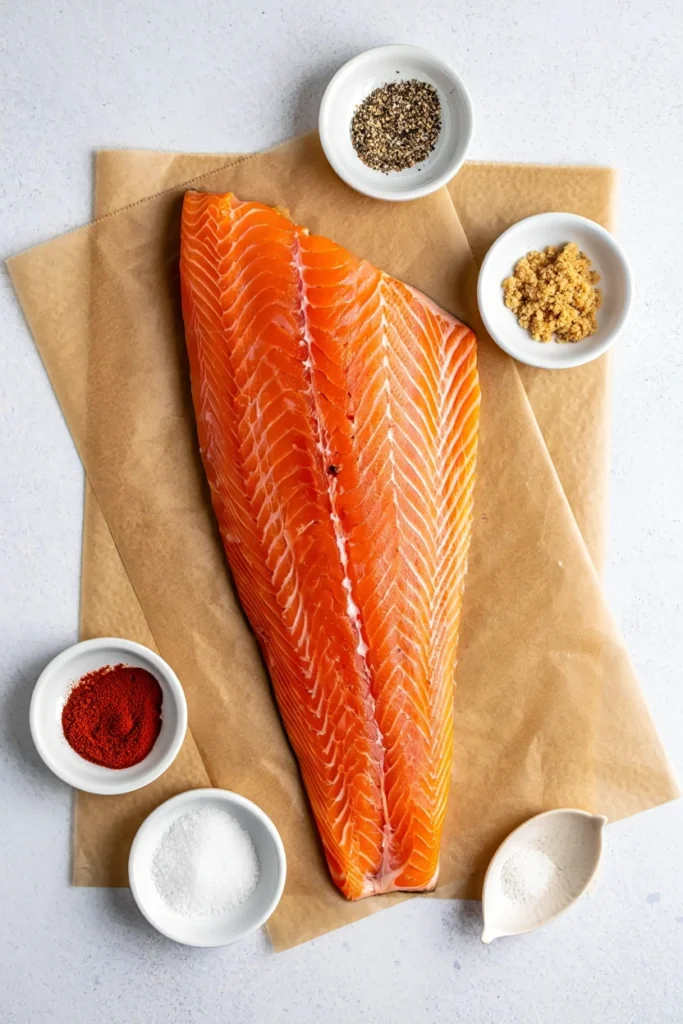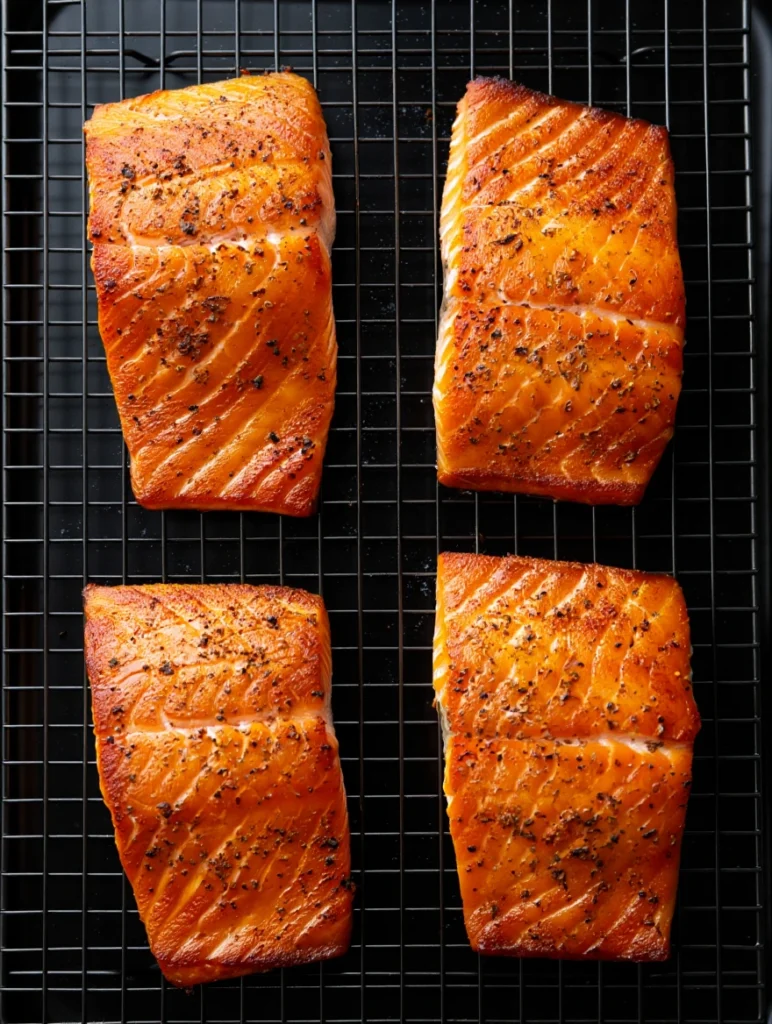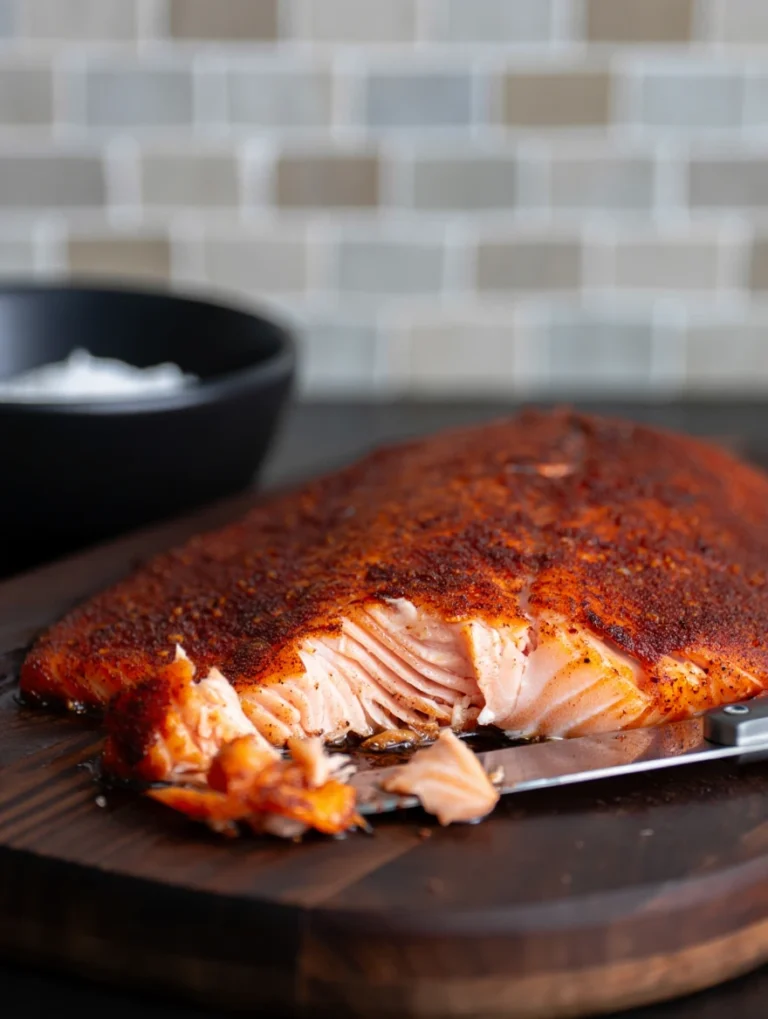Smoking salmon at home creates a delicious treat that rivals store-bought versions. This smoked salmon recipe uses a simple dry brine and smoking process that brings out the natural richness of the fish while adding complex smoky flavors. The technique works with both electric smokers and traditional charcoal setups, making it accessible for most home cooks. Fresh salmon fillets transform into buttery, smoky morsels perfect for breakfast spreads, appetizers, or main dishes. The process takes time but requires minimal hands-on effort, resulting in salmon with a beautiful color and texture that will impress family and friends.
Table of Contents
Reasons to Try Smoked Salmon
Homemade smoked salmon offers several advantages over store-bought versions. The flavor is fresher and can be customized to your preferences by adjusting the brine ingredients and smoking time. You control the quality of the salmon and avoid preservatives or additives often found in commercial products. The texture also tends to be superior—moist and tender rather than overly dry or salty. Making your own smoked salmon costs less than premium store versions, especially when salmon is on sale. The process itself is satisfying and fills your outdoor space with wonderful aromas as the salmon smokes to perfection.
Where did Smoked Salmon Come From?
Smoked salmon has ancient roots dating back thousands of years. Indigenous peoples of the Pacific Northwest, particularly tribes in what is now Alaska, British Columbia, and Washington, developed smoking techniques to preserve salmon for winter months when fresh fish wasn’t available. The method spread throughout northern Europe, where countries like Scotland, Norway, and Russia developed their own distinctive smoking traditions. In Scandinavian countries, cold-smoking became popular, while Native American traditions often used hot-smoking methods. The modern popularity of smoked salmon grew in the early 20th century when refrigeration made it possible to distribute this delicacy more widely, transforming it from a preservation necessity to a culinary luxury.
Ingredients Notes
 Save
Save- Fresh Salmon: Choose high-quality, fresh salmon with firm, translucent flesh. King (Chinook) or sockeye salmon work especially well for smoking due to their higher fat content, which keeps the fish moist during the smoking process.
- Kosher Salt: The coarse texture of kosher salt creates an effective dry brine without making the fish too salty.
- Brown Sugar: Balances the saltiness and helps form a sticky pellicle (outer layer) that captures smoke flavor.
- Black Pepper: Adds a mild heat that complements the rich salmon.
- Wood Chips: Alder wood is traditional for salmon smoking, offering a mild, sweet smoke. Apple, cherry, or maple chips also work well, providing subtle fruit notes.
How to Make Smoked Salmon
Step 1
Clean your salmon fillets by removing any pin bones with tweezers. Leave the skin on as it helps hold the fish together during smoking.
Step 2
Mix 1 cup kosher salt, ½ cup brown sugar, and 2 tablespoons black pepper in a bowl to create your dry brine.
Step 3
Line a large dish with plastic wrap. Sprinkle a thin layer of the brine mixture on the bottom, place salmon skin-side down, then cover the flesh completely with the remaining brine mixture.
Step 4
Wrap tightly with plastic wrap and refrigerate for 8-12 hours. For thicker fillets, brine for the full 12 hours.
Step 5
Remove salmon from the brine and rinse thoroughly under cold water to remove all salt and sugar.
Step 6
Pat the salmon completely dry with paper towels, then place on a wire rack, skin-side down.
Step 7
Allow salmon to air-dry in the refrigerator, uncovered, for 2-3 hours until the surface feels tacky. This forms the pellicle, which helps smoke adhere to the fish.
Step 8
Preheat your smoker to 175°F (80°C). Soak wood chips in water for 30 minutes, then drain.
Step 9
Place salmon skin-side down on the smoker rack and add wood chips according to your smoker’s instructions.
Step 10
Smoke for 3-4 hours until the internal temperature reaches 145°F (63°C) or until the flesh flakes easily with a fork.
Step 11
Remove from the smoker and let cool completely before slicing thinly against the grain.
What You Must Know About Smoked Salmon
The dry brining step cannot be rushed or skipped, as it draws out moisture and prepares the fish to absorb smoke flavor. Always check that your salmon reaches the safe internal temperature of 145°F (63°C) to prevent foodborne illness. Cutting corners on the air-drying step will result in poor smoke absorption and uneven cooking. The color of properly smoked salmon should be deep orange-pink, not pale or gray. If white proteins appear on the surface during smoking, this is normal and can be gently wiped away before serving.
Helpful Tips
Use a digital thermometer to monitor both the smoker temperature and the internal fish temperature for best results. For more even smoking, choose salmon fillets of similar thickness. If you notice the thinner sections cooking faster, you can remove them earlier. Adding a small pan of water in the smoker helps maintain humidity and prevents the salmon from drying out. For extra flavor, add fresh herbs like dill or thyme to the dry brine mixture. If you find the salmon too salty after your first attempt, reduce the brining time or salt quantity in your next batch.
Variations and Substitutions
- Honey Glazed: Replace brown sugar with honey in the brine, then brush salmon with a mix of honey and orange juice before smoking.
- Spicy Smoked Salmon: Add 1 tablespoon of crushed red pepper flakes or cayenne to the brine mixture.
- Herb-Infused: Mix 2 tablespoons each of chopped fresh dill and lemon zest into the brine.
- Tea-Smoked Salmon: Add 1/4 cup of loose black tea leaves to your wood chips for a unique flavor profile.
- Maple-Bourbon: Substitute maple sugar for brown sugar and add 2 tablespoons of bourbon to the brine mixture.
- Lower-Sodium Version: Reduce brining time to 4-6 hours and cut salt quantity by half.
Serving Suggestions for Smoked Salmon
Thinly sliced smoked salmon makes a beautiful addition to a breakfast or brunch board with bagels, cream cheese, capers, red onion, and lemon wedges. For elegant appetizers, roll small pieces around cream cheese and fresh herbs, or top cucumber rounds with salmon and a dollop of dill-infused sour cream. Create a smoked salmon pasta by tossing flaked pieces with cream sauce, peas, and fresh dill. For a light lunch, layer smoked salmon with avocado and microgreens on toast, or add to a fresh salad with a lemony vinaigrette. Smoked salmon also pairs wonderfully with scrambled eggs or as part of a grain bowl with quinoa, roasted vegetables, and a yogurt-based sauce.
 Save
SaveStorage/Reheating
Store smoked salmon in an airtight container in the refrigerator for up to 1 week. For longer storage, vacuum seal portions and freeze for up to 3 months. Thaw frozen smoked salmon overnight in the refrigerator before using. Smoked salmon is best enjoyed cold or at room temperature, as heating can make it dry and diminish its delicate flavor. If you must reheat it, do so very gently by adding it to warm dishes at the last minute, such as stirring into hot pasta just before serving.
Frequently Asked Questions about Smoked Salmon
Can I smoke salmon on a regular grill?
Yes, you can smoke salmon on a regular grill by setting up for indirect heat. Place soaked wood chips in a foil packet with holes poked in it, put it over direct heat, and place the salmon on the opposite side. Keep the temperature low and consistent.
How do I know when my smoked salmon is done?
Smoked salmon is done when it reaches an internal temperature of 145°F (63°C) and flakes easily with a fork. The color should deepen to a rich orange-pink, and the flesh should be firm but still moist.
Can I use frozen salmon for this recipe?
Yes, frozen salmon works well for smoking, but thaw it completely in the refrigerator first. Pat it dry thoroughly before applying the brine mixture.
Why is my smoked salmon too salty?
If your smoked salmon is too salty, you likely brined it too long or didn’t rinse it thoroughly enough after brining. Next time, reduce the brining time or the amount of salt in your brine mixture, and make sure to rinse well under cold running water.
What’s the difference between hot-smoked and cold-smoked salmon?
This recipe creates hot-smoked salmon, which is cooked through during the smoking process at temperatures around 175-225°F. Cold-smoked salmon is cured first, then smoked at much lower temperatures (below 85°F) for longer periods, resulting in a raw texture similar to lox.
Can I add other spices to the brine?
Absolutely! The basic brine recipe is just a starting point. Feel free to add garlic powder, onion powder, dried herbs, or even citrus zest to customize the flavor profile of your smoked salmon.
Other Salmon Recipes To Try:
Crispy Air Fryer Salmon Recipe
Smoked Salmon Recipe
Ingredients
- 2 pounds fresh salmon fillet with skin on
- 1 cup kosher salt
- 1/2 cup brown sugar
- 2 tablespoons freshly ground black pepper
- 2 cups wood chips preferably alder, apple, or cherry
Instructions
- Remove pin bones from salmon using tweezers.
- Mix kosher salt, brown sugar, and black pepper to create dry brine.
- Line dish with plastic wrap, add thin layer of brine mixture.
- Place salmon skin-side down on brine layer, cover flesh completely with remaining brine.
- Wrap tightly, refrigerate 8-12 hours.
- Rinse salmon thoroughly under cold water.
- Pat dry completely with paper towels.
- Place on wire rack skin-side down, refrigerate uncovered 2-3 hours until tacky.
- Preheat smoker to 175°F (80°C).
- Soak wood chips 30 minutes, drain.
- Place salmon skin-side down in smoker, add wood chips.
- Smoke 3-4 hours until internal temperature reaches 145°F (63°C).
- Remove, cool completely before slicing thinly against grain.
Notes
Nutrition Facts (Per Serving)
Based on a 3-ounce serving of homemade smoked salmon:- Calories: 150
- Protein: 21g
- Fat: 7g
- Saturated Fat: 1.5g
- Cholesterol: 60mg
- Sodium: 570mg
- Carbohydrates: 1g
- Sugar: 1g
- Fiber: 0g
Leave a Reply
Recipe Ratings
There are no reviews yet. Be the first one to write one.

